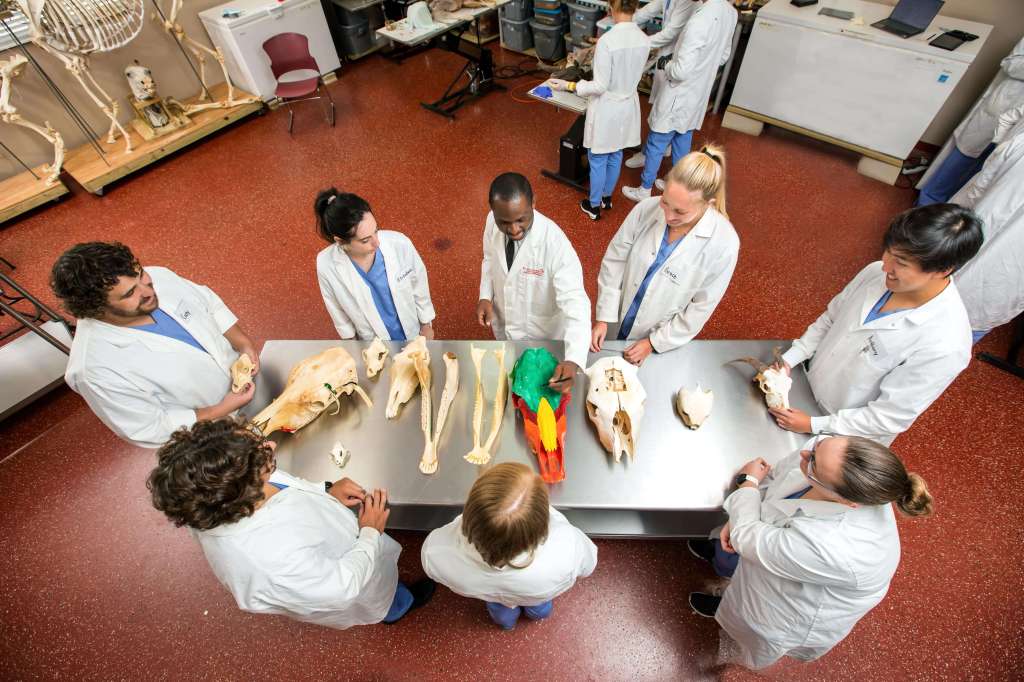
Clinical Medicine
DVM students in the Clinical Medicine program undertake rotations for three semesters at a vet school in the U.S., Canada, the U.K. or another country.
St. Matthew’s University School of Veterinary Medicine (SMUSVM) has established partnerships with veterinary colleges in the United States, Canada and the United Kingdom. These collaborations aim to bridge the gap between theoretical classroom learning and practical, hands-on experiences in real-world settings.
As part of these partnerships, SMUSVM students will have the opportunity to work alongside fourth-year veterinary students at a U.S., Canadian or U.K. institution. This unique arrangement allows them to directly engage with a diverse range of animal patients and utilize cutting-edge technology for diagnosing and treating life-threatening medical conditions.
Through a comprehensive series of clinical rotations within the mixed track programs offered by these schools, our clinical students will gain valuable experience in both small-animal and large-animal hospital settings. This integration of knowledge acquired during the preclinical years of study is a key focus of these rotations.
During their clinical rotations, students will develop crucial skills such as professional judgment, teamwork, problem-solving and effective communication. St. Matthew’s University will provide oversight and support to ensure a smooth transition from our Grand Cayman campus to the clinical programs, ultimately leading to the success of our students in their clinical training.



Clinical students dedicate a significant amount of time to thoroughly analyzing cases and providing well-founded explanations for their conclusions.
Over the span of one year (three semesters), DVM students participate in closely supervised externships that provide them with firsthand experience in the field of veterinary practice and can serve as a stepping stone to career advancement.
Students who successfully complete the Clinical Medicine program are eligible for a Doctor of Veterinary Medicine (DVM) degree from St. Matthew’s University.
Canada:
University of Guelph, Ontario Veterinary College
https://ovc.uoguelph.ca
University of Prince Edward Island, Atlantic Veterinary College
http://www.upei.ca/avc/
United Kingdom
The University of Edinburgh, The Royal (Dick) School of Veterinary Studies
https://vet.ed.ac.uk
United States:
Iowa State University
https://vetmed.iastate.edu/
Mississippi State University
https://www.vetmed.msstate.edu/
University of Illinois Urbana-Champaign
https://vetmed.illinois.edu/
University of Missouri
https://cvm.missouri.edu/
Washington State University
http://www.vetmed.wsu.edu/
PAVE and ECFVG Licensure
In order to practice in the United States, graduates of St. Matthew’s University School of Veterinary Medicine must be certified by either the Programmatic Assessment of Veterinary Education Equivalence (PAVE), a component of the American Association of Veterinary State Boards (AAVSB), or the Educational Commission for Foreign Veterinary Graduates (ECFVG), a committee of the American Veterinary Medical Association (AVMA). After successfully completing either of these programs, the student is eligible to take the North American Veterinary Licensing Exam (NAVLE).
The process for these two pathways is somewhat similar but not identical. Both require proof of competency in English, either by proof of education in an English speaking high school or via exam (TOEFL or IELTS).
About PAVE:
For the PAVE program, the candidate can take the Qualifying Exam (QE) during either semester 6 or 7 on campus. Success in passing the QE then allows the student to have a state that accepts PAVE certify them to take the NAVLE. If you are following the PAVE program, the student can then take the NAVLE near the end of their clinical program. The NAVLE exam is given in November/December and in April each year.
An important point is that if you have passed the PAVE QE prior to doing your clinical training year in an AVMA accredited school/college, you have fulfilled the clinical competency requirement and do not need to take any further exams related to clinical competency.
At the present time, most U.S. states (exceptions include Alabama, Alaska, Hawaii, Nevada and New Mexico) and Puerto Rico, all provinces in Canada, as well as Australia and New Zealand, accept the PAVE program as a basis for licensure. For more complete information, visit the website: http://www.aavsb.org/pave.
About ECFVG:
For the ECFVG program, after meeting the English requirement, the candidate must pass the Basic and Clinical Sciences Exam (BCSE). Completion of this exam then permits you to take the NAVLE during your clinical year.
After graduation, the candidate must then take and pass the Clinical Proficiency Examination (CPE). The primary site for this exam is the Oquendo Center in Las Vegas and some U.S. Veterinary Schools also administer this exam. More information on the ECFVG program is available at http://www.avma.org.
Students who intend to practice outside the U.S. must meet the licensing requirements of the country in which they want to practice.
Get in Touch for More Information